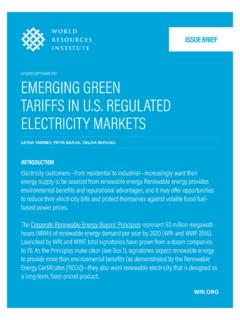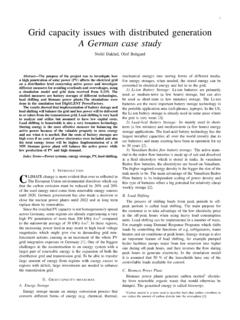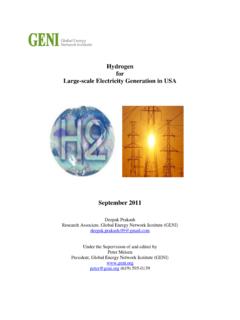Transcription of Adding gas from biomass to the gas grid - Hem | SGC
1 Swedish Gas Center - July 2001 Adding gas from biomass to thegas gridReport SGC 118 GASTEC NVMartin HagenErik PolmanDanish Gas Technology Center a/sJan K JensenAsger MykenSwedish Gas CenterOwe J nssonAnders DahlReport SGC 118 ISSN 1102-7371 ISRN SGC-R-118-SEFOREWORDRD&D-projects performed by the Swedish Gas Center, are usuallypresented in reports, available to each and everyone who wants to share theresults of a prints and publishes the reports but the authors of each report areresponsible for the accuracy of the content. Everyone making use of anydescription, results etc, will do this on his own responsibility. Excerpts froma report may be used if the source is indicatedSwedish Gas Centre (SGC) is a joint venture of energy gas businessorganisations.
2 SGC s primary mission is to co-ordinate the joint Research,Development and Demonstration (RD&D) efforts that are performed withinthe Swedish gas industry. The shareholders of SGC are: The Swedish GasAssociation, Sydgas AB, Sydkraft AB, Gothenburg Energy, Lund Energyand Helsingborg project has been funded by: The European CommissionThe Swedish National Energy AdministrationGastec , HollandDanish Gas Technology Center, DenmarkNSR, SwedenSydgasVattenfall Naturgas ABG teborg Energi ABBirka Energi AB resundskraft ABRVF - The Swedish Association of Waste ManagementLunds Energi ABSYSAV ABSWEDISH GAS CENTREJ ohan RietzPresidentpage: 2 CONTENTSPage1 INTRODUCTION32 IMPORTANCE OF Adding GAS FROM biomass TO THE GAS biomass for Utilisation of energy from Economical aspects133 PRODUCING GAS FROM Biogas from anaerobic Syngas from biomass pyrolysis and gasification 204 PIPELINE QUALITY GAS FROM Upgrading Addition of Adaption to non natural gas Odorisation485 PIPELINE QUALITY GAS FROM Process Conversion and Process integration546 SUPPLYING GAS FROM biomass TO THE GAS Gas quality Control and Prospects767 INTERNATIONAL Availability of Examples of pipeline quality gas from biomass by Policy958 CONCLUSIONS AND RECOMMENDATIONS1169 REFERENCES117 Appendix 1.
3 Abbreviations, terminology and units122 Appendix 2: Thermal gas production processes123page: 31 INTRODUCTIONN owadays there are only a few biomass gasification plants operative worldwide delivering gas tothe grid . One of the main reasons for this is that gas from biomass is hardly competitive with naturalgas or other sources of energy. Useful application of the produced heat is in most cases restrictedto local utilisation, since large distance transport of heat is economically way to improve the economics is to use biogas via the gas grid at locations where all biogas canbe used efficiently at any time. This use may involve for example the conversion to heat orelectricity, or use as a vehicle fuel.
4 One way to accomplish this is Adding the biogas to the naturalgas grid . The other way is to utilise a dedicated gas distribution grid with end-user applications fit forthe local gas aim of this project carried out in the framework of the Altener programme is to provide anoverview of technologies for cleaning and upgrading of biogas for remote use. A further aim is todetermine to what extent gases produced from biomass (digestion or gasification) can be added tothe gas grid and what additional safety regulations are necessary. Finally, existing Europeanstandards and national legislation have been studied in order to determine the possibility ofconflicting and/or missing regulations with the intended approach.
5 The information collected in thisproject can be used to select promising technologies and may serve as background information fordeveloping harmonised report describes the various production and cleaning techniques and the present requirementsfor the use of technology for Adding gas from biomass to the gas grid on a larger scale can contribute to ahigher share of biomass in the energy supply and will also allow a highly efficient use of the energycontained in the biomass . Moderate tax incentives will make the use of gas from biomasseconomically attractive for large groups of project was financed by: European Commision in the Alterner program and in: the Netherlands by: EnergieNed and NOVEM, Denmark by: DONG, Hoverstadsregion Naturgas I/S, Naturgas Sj lland I/S, Naturgas Fyn I/S,Naturgas Midt-Nord I/S, K benhavns Energi, The Danisch Energy Agency and Sweden by: funds provided by the Swedish natural gas distribution companies and the SwedishEnergy Polman (Gastec) provided the project management.
6 The production of the final report wasprovided by Marijke Jansen en Rosalien : 42 IMPORTANCE OF Adding GAS FROM biomass TO THE GAS biomass FOR ENERGYB iomass is one of the most important sources of renewable energy. The European Commissiondepicts in its 1997 White Paper Energy for the Future: renewable sources of energy [ ] astrategy and action plan for the enhanced use of renewable energy sources. Table 1 summarisessome data from this White Paper. This paper distinguishes two energy products from biomass : heatand electricity. The paper assumes that all heat released from biomass is generated with anefficiency of 100%. The efficiency for the production of electricity is assumed to increase from 29%in 1995 to 33% in 2010.
7 The heat generated in the production of electricity is not considered to beused. In practice a large part of the heat will find a useful utilised renewable energy sourcesPJ 3100 7600biomass for energyPJ 1870 5650contribution of biomass in the total of renewable energy sources%6074heat from biomassPJ 1590 3140biomass for electricity productionPJ 280 2510electricity from biomassPJ 83 830conversion efficiency%2933 Table 1: EC s White Paper data on the growth of utilisation of the energy from biomassBiomass is the most important contributor to the growth in renewable energy sources. Between1995 and 2010 3780 PJ1 of biomass capacity will be installed. The cost effectivity for using energyfrom biomass equals that of hydro and wind power but is better compared to other sources ofrenewable energy as photovoltaic or geothermal by a factor three to for energy use can be found everywhere in nature.
8 biomass can also be generated forenergy use in the rehabilitation of regenerated lands, agroforestry, urban and community plantations, when managed properly, can be successful, as already demonstrated in, forexample, Ethiopia and Brazil [ ]. biomass is also a by-product in the production of food andtimber. These by-products, often more than 50% of the total input, constitute an important source ofsustainable technology of the conversion of biomass to energy can also be used to produce energy fromother organic waste (manure, plastics, tires, industrial wastes). Conversion of these organic wastesnot only contributes to the energy supply, but also reduces their adverse impact on the worldwide production of biomass on the land surface exceeds the energy consumption by afactor 100 [ ].
9 Only a part of this biomass is, by its remote location and dispersed nature,available for energy production. Even from the biomass available for energy production currently 1 Recalculated from Mtoe: million tonnes of oil equivalent: 1 Mtoe = 42 PJ; 1 PJ = 1015 Joulepage: 5only a small part is utilised. In case of utilisation the efficiency, in which the energy in the biomass isconverted to useful energy, is below a readily achievable level. Notwithstanding this sub-optimalutilisation, biomass already in 1990 contributed to 13% of all primary energy [ ]. It is estimatedthat in 2050 nearly 40% of the direct fuel use and 17% of the power production will be provided gas from biogasThe concept of the production of distribution quality gas from biomass is not incorporated in theWhite Paper on renewable energy.
10 This concept however can substantially improve the utilisation ofenergy from biomass . In this concept biomass is converted to a gas fit for supplication to a gas grid ,the pipeline quality to the local low-pressure gas grid allows a highly efficient application of the energy inbiomass. On the expense of compression and upgrading to transport grid pressure and qualitybiogas can be fed to the pan-European gas grid allowing a virtually unrestricted production ofenergy from means that pipeline quality gas from biomass allows:Accommodation of virtually any production at any time at any place near the gas gridAs long as a connection with a sufficient capacity to the natural gas grid exists, all pipeline qualitygas can be accommodated.








